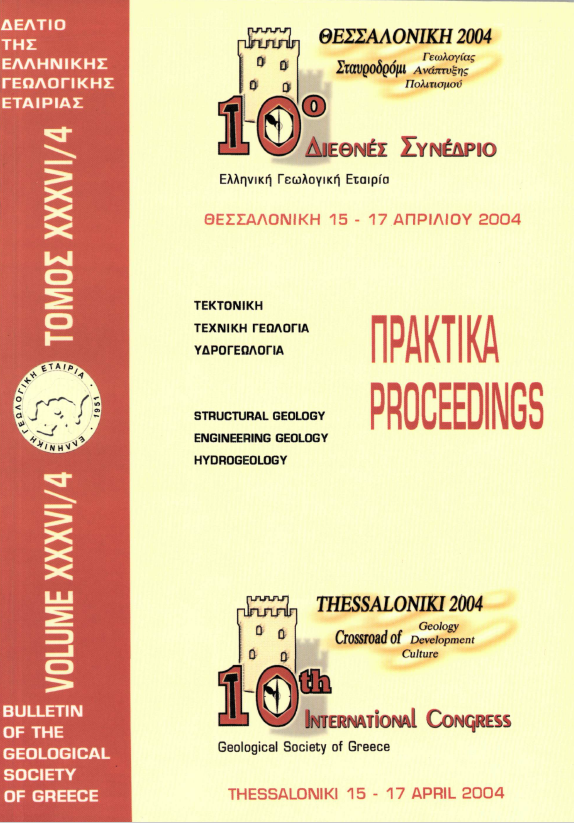Cretaceous structural evolution of the Pelagonian crystalline in western Voras Mt (Macedonia, Northern Greece)
Résumé
The kinematic of the Cretaceous deformation and the relationship between deformation and metamorphism of the Pelagonian crystalline was studied in Voras Mt (northern Greece). The Pelagonian crystalline in this area has been subdivided into a lower, core part, consisting mainly of gneissic rocks and schists and an upper, cover part, consistine of schists and quartzites with marble intercalations. Intensely deformed granitic rocks of Upper Paleozoic age intrude the Pelagonian crystalline basement. An S j foliation is the oldest fabric recognized in the Pelagonian crystalline. Sj is mainly defined by syn-Sjgarnet(Gr1), biotite(Btj), white mica (Wnij), chloritoid, kyanite and plagioclase in the metapelitic rocks and green amphibole, epidote, plagioclase, and biotiteiBtj) in the amphibolite. Garnet grows also in some cases post-kinematically. Ilmenite and tourmaline are often found in the pelitic rocks as well. S is overprinted by an S2 foliation that developed as a crenulation cleavage. In most places, however, S2 has destroyed all earlier fabrics and a single S2 fabric is present related to, isoclinal or sheath folds intrafolial in places. S2 in the metapelitic rocks is characterized by the syn-S2 development of chlorite, white mica(Wm2) and plagioclase. In the amphibolite S2 is mainly defined by the syn-kinematic development of actinolite, plagioclase, biotite(Bt2), white mica(Wm2) and chlorite. During D2 garnet(Gr1) and biotiteiBtj) are partially replaced by chlorite, while green amphibole is replaced by actinolite and chlorite. Chloritoid remains generally stable along the S2-planes but in some places transforms to chlorite and sericite. Furthermore, D2 was locally followed by a static post-kinematic annealing indicated by polygonal quartz microfabrics with equilibrated grain boundaries and triple points. The overall orientation of S2 is dome shaped with a gentle SW-ward and NE-ward dip in the southwestern and northeastern flanks of the dome respectively. Syn-S2 minerals defined a very well exposed NW-SE trending stretching lineation. Kinematic indicators show a main top to the SE sense of movement. An S3 crenulation cleavage associated with asymmetric NW-SE trending folds is also present in most parts of the core and cover rocks, possibly, related to a constrictional type of deformation. A well developed, S4 shear band cleavage is mainly present in the upper parts of the metamorphic dome and formed under cooler conditions. S4 shear bands are associated with a NW-SE developed stretching lineation defined by elongated and dynamically recrystallized quartz grains and a preferred orientation of white mica and chlorite. Along the S4 shear bands a transformation of garnet, biotite, chloritoid and amphibole into chlorite is always observed. S4 shear bands indicate a main top to the SE sense of movement. The P-T metamorphic conditions were derived from textural equilibria and mineral assemblages, as well as from the spatial distribution of the metamorphic minerals. Syn-Dj metamorphism reached the conditions of the boundaries between greenschist and amphibolite facies. Syn-D2 retrogression took place under greenschist facie conditions. K/Ar radiometric datings on coarse-grained syn-St and younger fine-grained syn-S2 micas define an Early Cretaceous cooling age ('135Ma) for the older event and a Mid- to Late Cretaceous age ('90-80Ma) for the second event. A white mica age of ca. 65Ma correlates with S4 shear band clevage. Furthermore, the intrusion age of a granitic body into the Pelagonian crystalline is dated using the Pb/Pb single zircon evaporation method. The estimated intrusion age of 300±3Ma suggests that the Pelagonian crystalline was affected by a pre-kinematic magmatic activity relative to its Cretaceous deformation.
Article Details
- Comment citer
-
ΑΥΓΕΡΙΝΑΣ Α., ΚΙΛΙΑΣ Α., ΚΟΡΩΝΑΙΟΣ Α., ΜΟΥΝΤΡΑΚΗΣ Δ., FRISCH, W., DUNKL, I., & MOST Τ. (2001). Cretaceous structural evolution of the Pelagonian crystalline in western Voras Mt (Macedonia, Northern Greece). Bulletin of the Geological Society of Greece, 34(1), 129–136. https://doi.org/10.12681/bgsg.16952
- Rubrique
- Tectonics

Ce travail est disponible sous licence Creative Commons Attribution - Pas d’Utilisation Commerciale 4.0 International.
Authors who publish with this journal agree to the following terms:
Authors retain copyright and grant the journal right of first publication with the work simultaneously licensed under a Creative Commons Attribution Non-Commercial License that allows others to share the work with an acknowledgement of the work's authorship and initial publication in this journal.
Authors are able to enter into separate, additional contractual arrangements for the non-exclusive distribution of the journal's published version of the work (e.g. post it to an institutional repository or publish it in a book), with an acknowledgement of its initial publication in this journal. Authors are permitted and encouraged to post their work online (preferably in institutional repositories or on their website) prior to and during the submission process, as it can lead to productive exchanges, as well as earlier and greater citation of published work.






